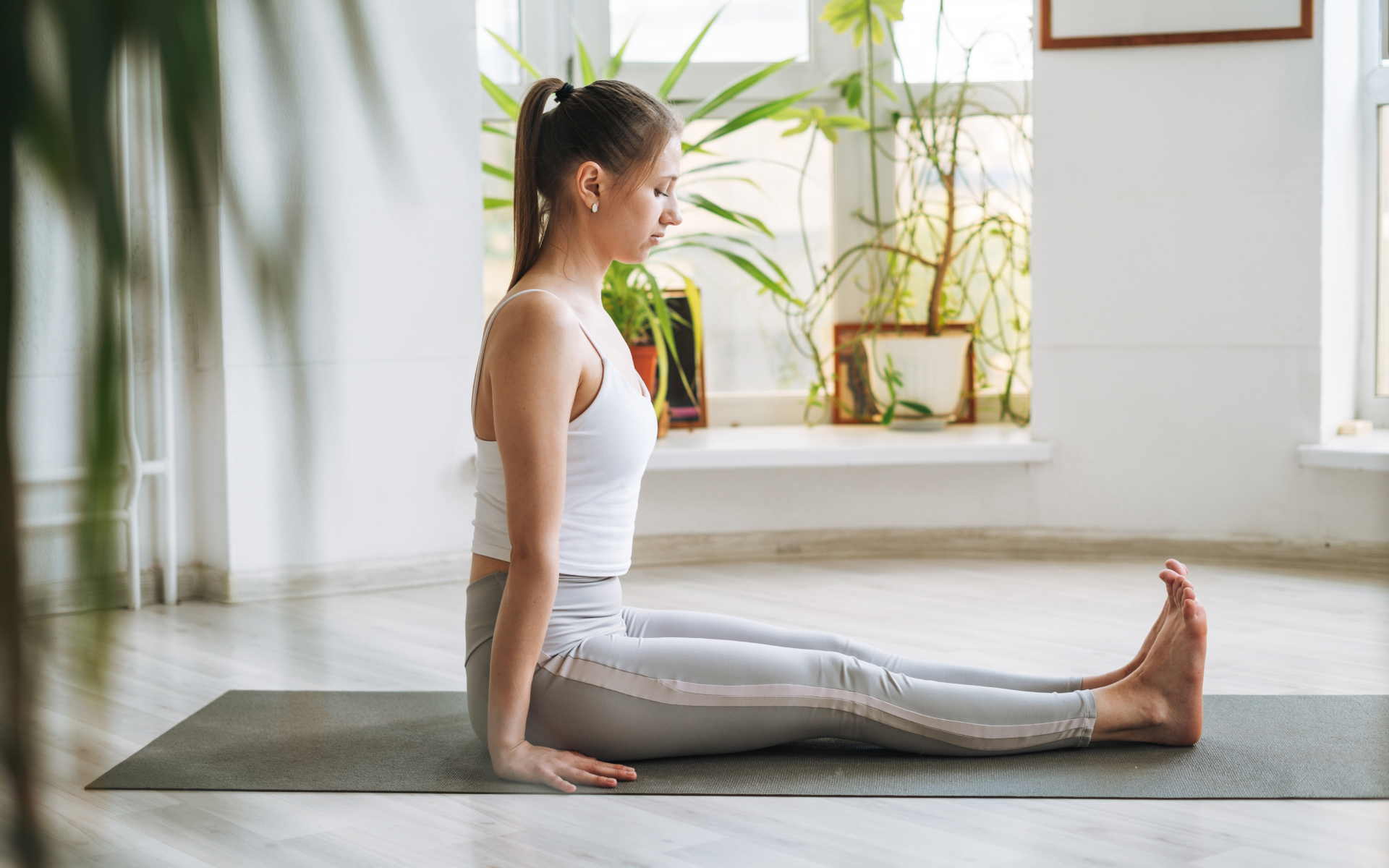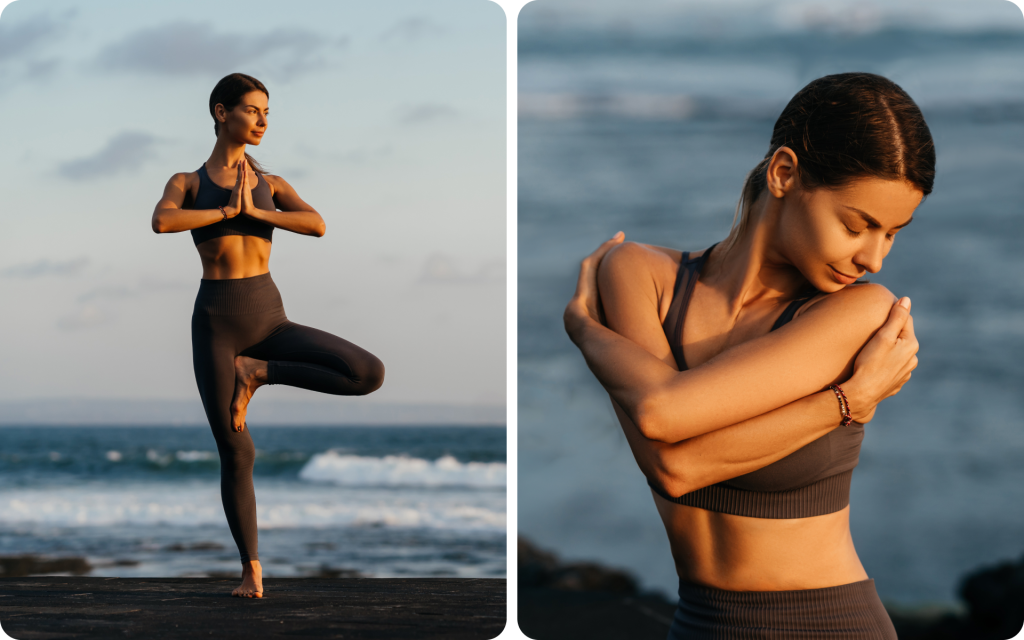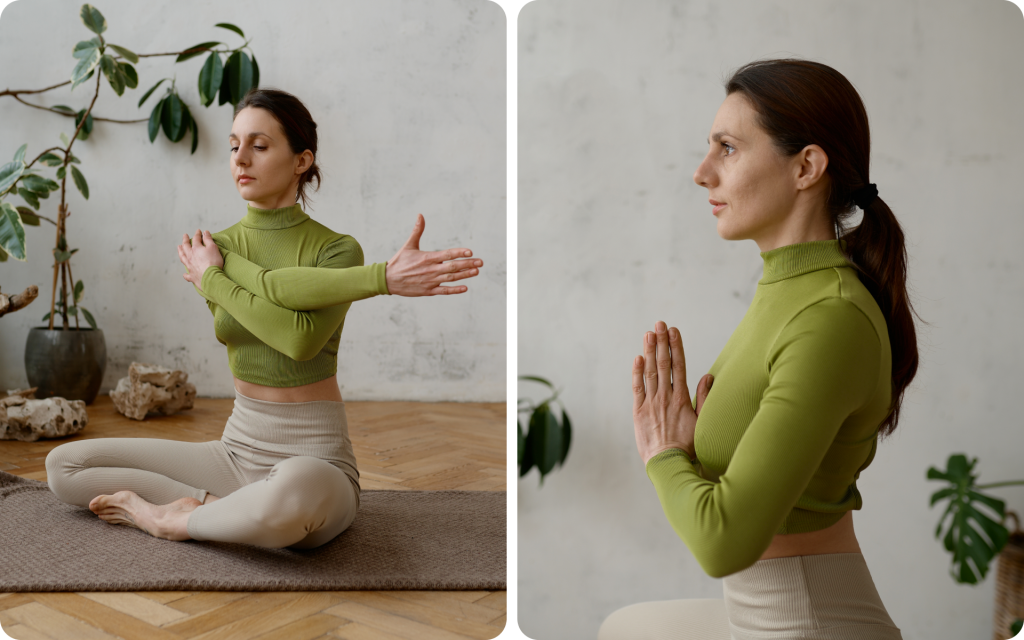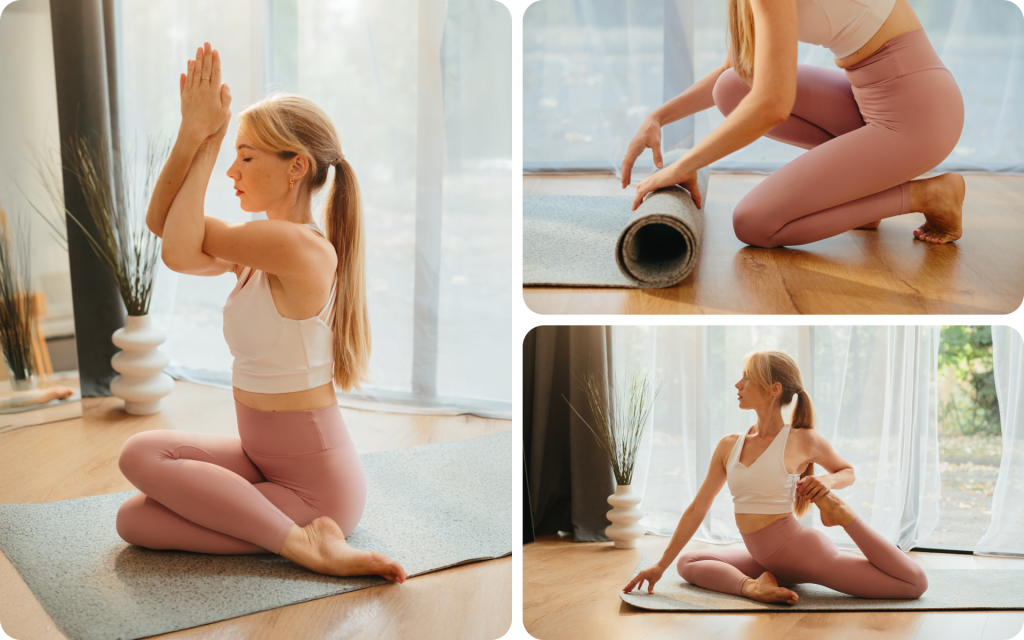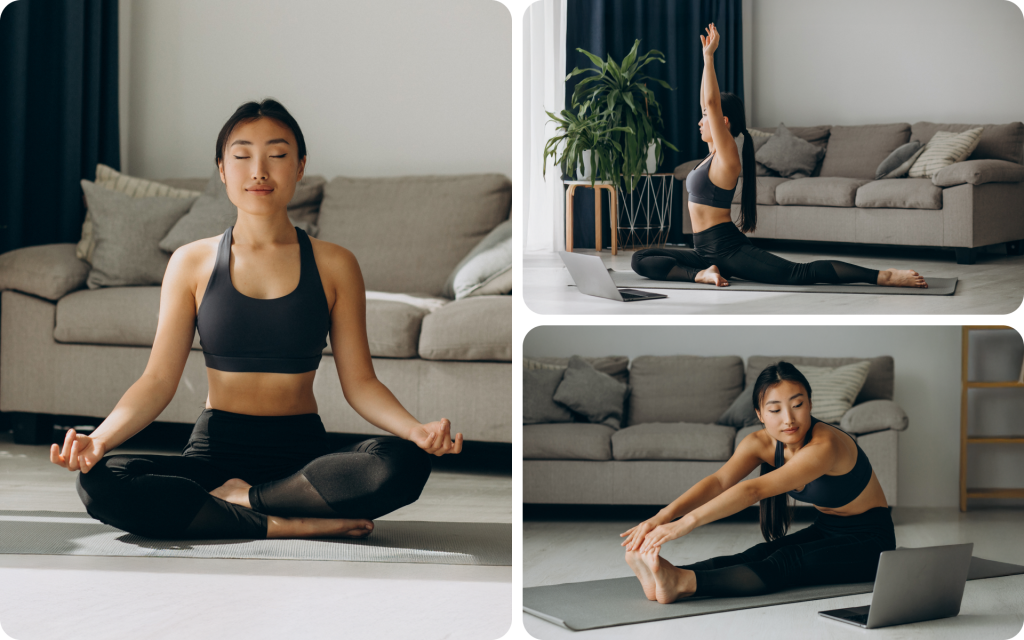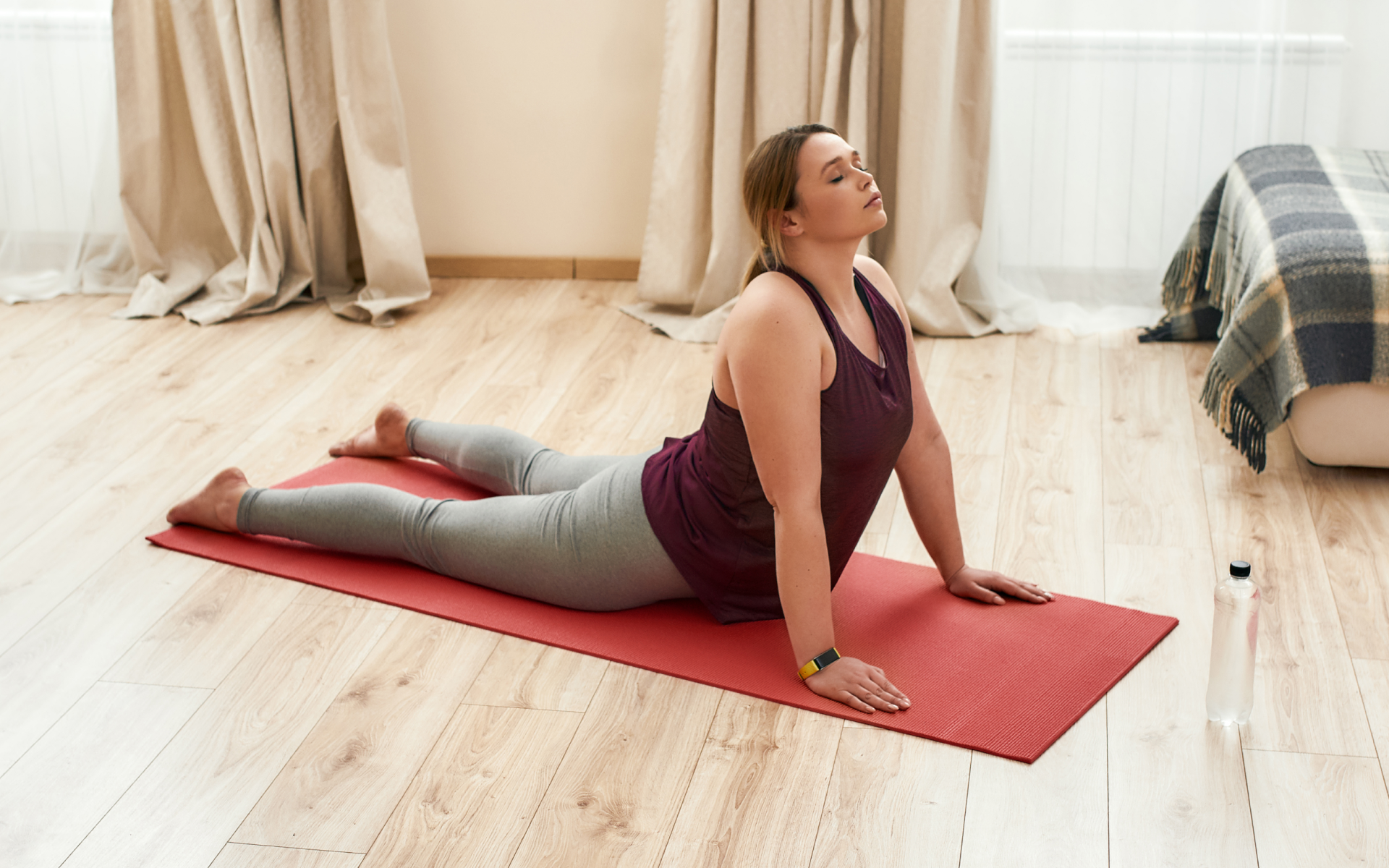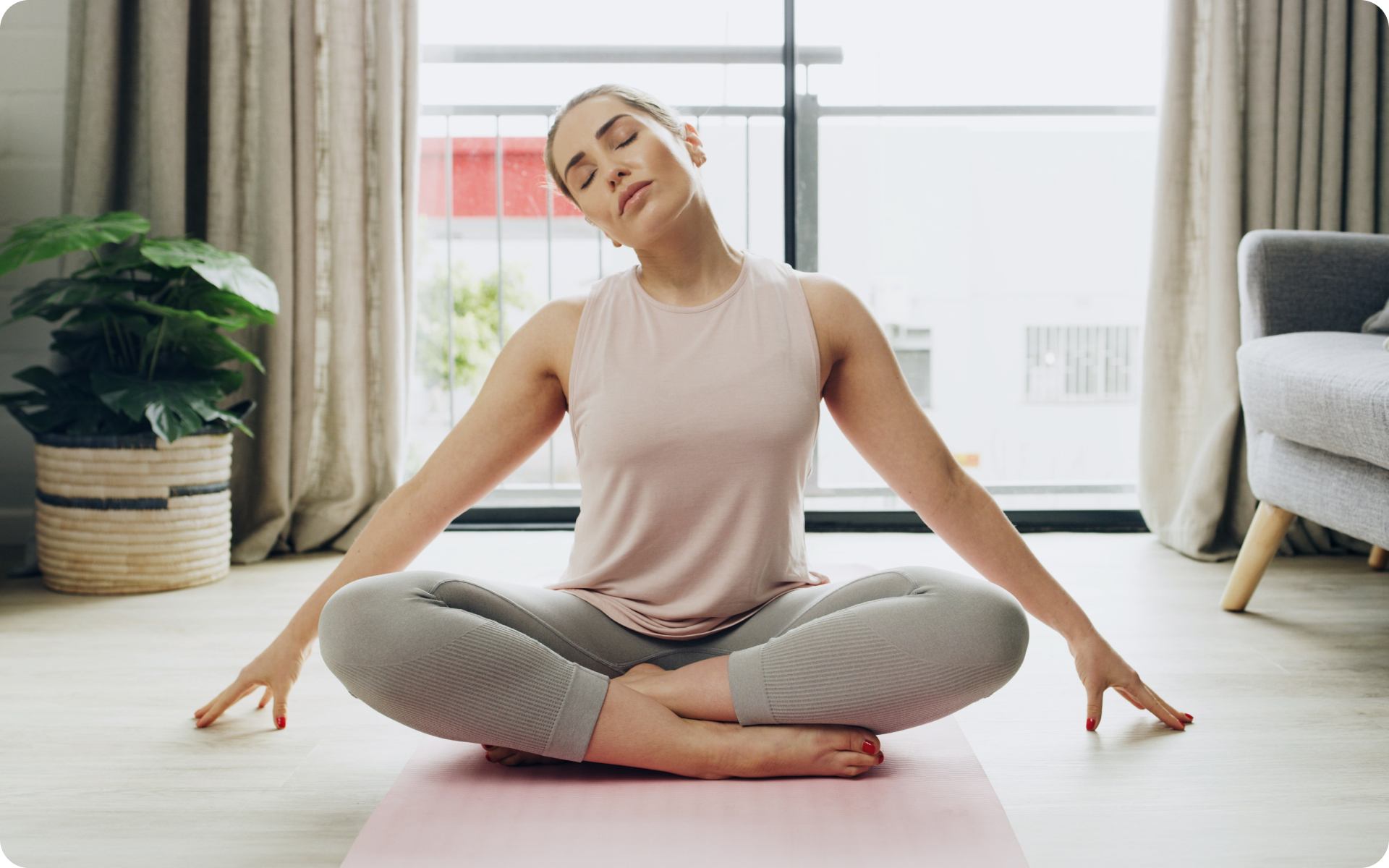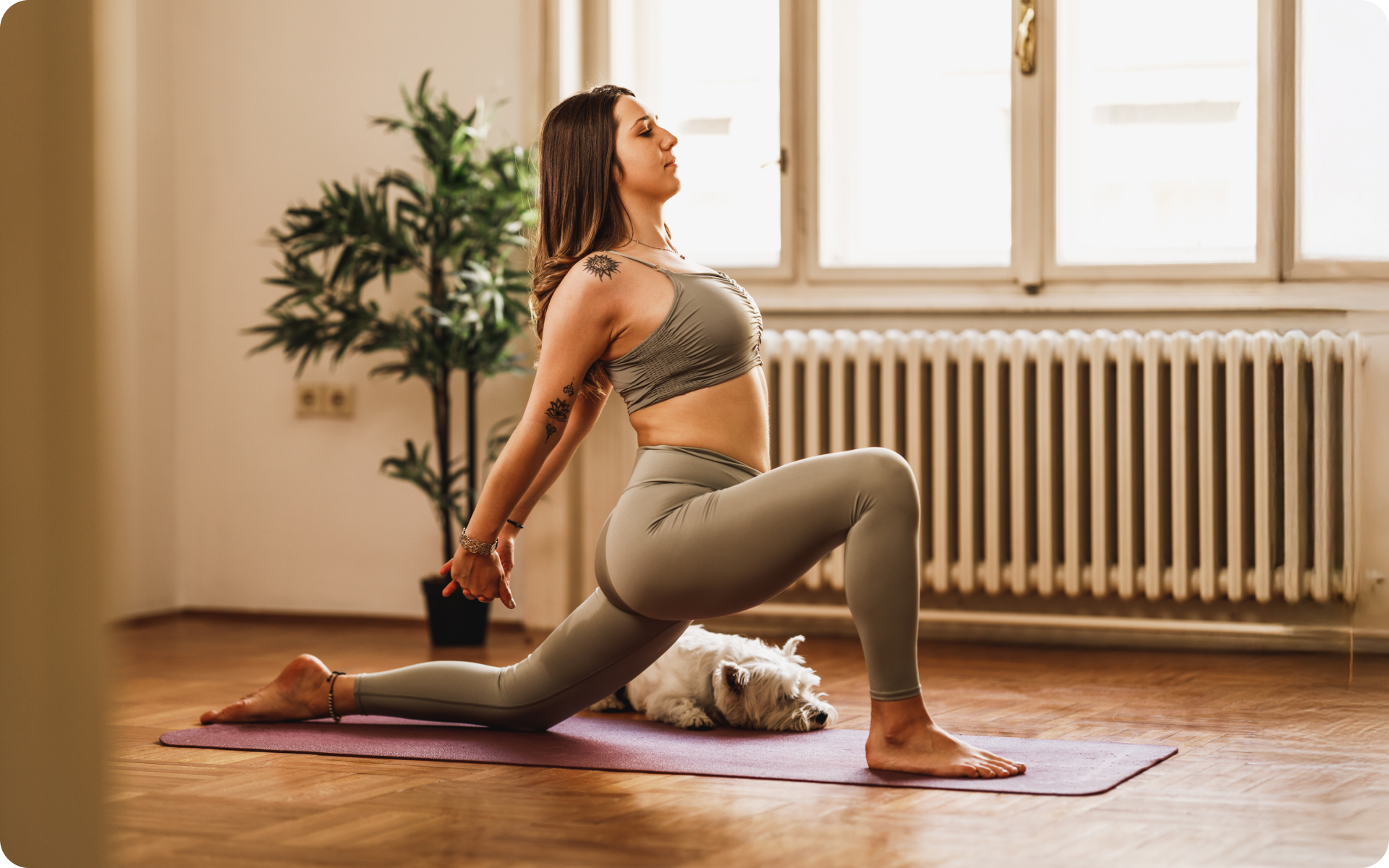A flowing somatic yoga sequence is an intentional, body-oriented practice that connects gentle, fluid movements with breath awareness and sensory attention.
Somatic yoga emphasizes internal experience, how movement feels rather than how it looks. A flowing sequence moves smoothly from one posture to another, which allows the nervous system to unwind, release tension, and restore natural ease of motion. It’s suitable for all levels, including beginners and seniors, and can be adapted to support relaxation, mobility, emotional regulation, or pain relief.
It’s not just movement, it’s a conversation with your body, inviting balance, calm, and effortless flow back into your life.
How Do I Start Somatic Yoga?
Starting somatic yoga is easier than you might think, it’s really about slowing down and learning to listen to your body. Find a quiet space where you can move without distractions. You don’t need any fancy equipment – just a mat, a little space, and an open mind.
Begin on the floor, either lying down or seated, so your body feels fully supported. From here, start with small, gentle movements, think of rolling your shoulders, rocking your pelvis, or softly swaying your spine. Move slowly, breathe naturally, and notice what feels tight, heavy, or relaxed. The magic of somatic yoga lies in these tiny, intentional movements that help you reconnect with how your body feels from the inside out. If you’re curious about yoga sequences for beginners, check out our earlier article.
There’s no pressure to “get it right”. In fact, the goal isn’t performance, it’s bodily awareness. When you move slowly and curiously, your body begins to release built-up tension and find its natural rhythm again.
If you’re new to this practice, you can follow along with a guided somatic yoga video or online class, especially ones that are designed for beginners or relaxation. Over time, you’ll start to sense what your body needs each day and create your own mini-flows that feel good for you. Remember, somatic yoga is about progress through presence, not perfection.
Reasons why BetterMe is a safe bet: a wide range of calorie-blasting workouts, finger-licking recipes, 24/7 support, challenges that’ll keep you on your best game, and that just scratches the surface! Start using our app and watch the magic happen.
What Defines a Somatic Yoga Sequence?
To understand what makes a somatic yoga sequence unique, it helps to break down the words themselves. Somatic comes from the Greek word “soma”, meaning “the living body in its wholeness” (1). It refers to being fully present in your body, not just moving it, but actually feeling it from the inside. A yoga sequence, on the other hand, is simply a series of yoga poses or movements arranged in a particular order to create a flow.
Now, a somatic yoga sequence blends these two ideas, it’s not about perfect poses or following a rigid routine, but about creating a fluid, intentional flow that responds to how your body feels in the moment (2). Each movement melts naturally into the next, guided by your breath and internal sensations rather than strict choreography. For more details about somatic yoga exercises, take a look at our prior publication.
What truly defines a somatic yoga sequence is its intention and flow. The goal isn’t to perform, but to repattern your body’s habitual responses, which helps you release tension, improve body awareness (proprioception), and rediscover natural ease in movement (3).
A typical sequence might include gentle, familiar poses such as cat-cow, bridge, or child’s pose mixed with slow, intentional somatic exercises and deep, rhythmic breathing. Everything is done in a way that feels organic and nurturing. Over time, these flowing sequences will help you reconnect with your body’s intelligence, bringing a deep sense of calm, mobility, and inner balance.
Read more: 6 Somatic Yoga Exercises for Beginners
How Do I Find the Right Somatic Yoga Sequence for Me?
Finding the right somatic yoga sequence is a bit like finding the right rhythm for your day, it all depends on how your body and mind feel. The beauty of somatic yoga is that there’s no one-size-fits-all approach. Instead, it’s about listening to your body’s cues and choosing movements that meet you where you are.
Start by asking yourself what your body needs most right now. Do you feel tense, tired, anxious, or stiff? Each state calls for a different kind of flow:
- If your muscles feel tight or heavy, try a slow, floor-based somatic yoga sequence for beginners that’s focused on releasing stiffness through gentle, conscious motion.
- If you’re craving emotional release or deep relaxation, explore flowing somatic yoga exercises that emphasize the breath and the spine, movements that help energy and emotion move freely through the body.
- If you’re a senior or prefer low-impact movement, opt for a somatic yoga sequence for seniors, designed to support joint mobility, balance, and stability in a soothing way.
The key is to experiment – try different sequences and notice how your body responds, where it feels lighter, calmer, or more open. That feedback is your best teacher. Over time, you’ll naturally discover which sequences feel most restorative and which ones bring you energy or focus. Somatic yoga is a personal journey of connection and discovery – your body will always guide you to the practice it needs most.
What Are the Easiest Somatic Yoga Sequences for Beginners?
If you’re new to somatic yoga, the best place to start is with simple, gentle sequences that help you reconnect with your body without strain or pressure. These beginner-friendly flows are all about slow, body-aware movement and comfortable exploration – perfect for easing tension, improving awareness, and setting the foundation for deeper practice later on.
Here are a few easy and effective somatic yoga sequences to try:
- Somatic cat-cow flow – Begin on your hands and knees. Instead of moving on autopilot, slowly arch and round your spine while paying attention to how each vertebra feels. Pause wherever you notice stiffness or ease, and move only as much as feels right. Let your breath lead the motion, inhale to expand, exhale to release.
- Pelvic clock sequence – Lie on your back with your knees bent and your feet flat. Imagine your pelvis as the face of a clock. Gently rock it toward 12 o’clock (navel), then 6 o’clock (tailbone), then side to side. Move slowly, sensing how your lower back and hips respond. This develops pelvic awareness and releases stored tension.
- Somatic bridge flow – From lying on your back, lift your hips just a few inches on an inhale, then melt them down on the exhale. Notice the weight shifting through your feet, spine, and shoulders. Allow the movement to feel wave-like rather than mechanical, awakening the back body and encouraging natural breath flow.
- Somatic side bend sequence – Seated or standing, gently lean your body to one side, reaching your arm overhead in a slow, continuous motion. Feel the lengthening through your ribs and waist. Move back through the center and to the other side, keeping your focus on breath and sensation rather than stretch depth.
These gentle yoga sequence ideas can be practiced daily in the morning or evening, and are easily adjusted for your comfort level. Focus on moving slowly, breathing deeply, and noticing how your body feels with each movement. With regular practice, you’ll start to feel more open, relaxed, and connected to your body’s natural rhythm. Our previous post goes into great detail about the somatic yoga poses.
Whether you’re a workout beast or just a beginner making your first foray into the world of fitness and dieting – BetterMe has a lot to offer to both newbies and experts! Install the app and experience the versatility first-hand!
How Can Beginners Memorize a Somatic Yoga Sequence?
When you’re first learning somatic yoga, it’s easy to wonder how you’ll remember all the movements, but here’s the good news: you don’t have to memorize perfectly. Somatic yoga is all about feeling your way through rather than following a rigid set of steps. In fact, the more you focus on sensation instead of sequence, the more naturally your body remembers what to do.
Start by breaking your practice into small, simple sections, just two or three movements at a time. For example, start with gentle pelvic tilts or slow spinal rolls before you move on to other poses. Practice these a few times until they feel familiar. This repetition helps build what’s called body memory, where your muscles and nervous system start to recall the flow without conscious effort (4).
You can also use visual or auditory cues to support your memory. Try writing down your favorite sequence of yoga poses, record yourself describing the movements, or follow a guided video until you’re comfortable. Over time, you’ll find that your body begins to lead the way, remembering the sensations even when your mind doesn’t.
The beauty of somatic yoga is that there’s no pressure to get it perfect – each practice is a new opportunity to explore how your body feels that day. As you repeat and refine your movements, you’ll notice deeper benefits (5):
- Improved body awareness as your nervous system learns to recognize subtle sensations.
- Better coordination and fluidity through gentle repetition.
- Reduced tension and stress, as intentional movement helps calm both body and mind.
- Increased confidence in creating your own mini-flows that suit your needs.
So instead of memorizing by rote, let your body remember through rhythm, breath, and awareness. In somatic yoga, learning isn’t about recalling steps, it’s about reconnecting with the wisdom already living in your body.
Read more: Somatic Yoga Moves Explained: Benefits, Examples, and How to Begin
How Do You Adapt Somatic Yoga Sequences to Personal Goals?
One of the most beautiful things about somatic yoga is its flexibility – it meets you exactly where you are, regardless of your age, ability, or energy level. As the practice is guided by body awareness rather than strict routines, it can be easily shaped to support whatever your personal goals may be, whether that’s easing stress, improving posture, or boosting mobility.
Start by identifying what you want to focus on, then gently adjust the intensity, pace, and duration of your movements to fit that intention.
For example:
- If your goal is relaxation or stress relief, choose slower, grounding flows that keep you close to the floor. Movements such as gentle pelvic rocking or slow spinal twists help calm the nervous system and promote deep rest.
- If you want to increase energy and mobility, experiment with more dynamic, flowing sequences that include standing movements and rhythmic breathing to awaken your body.
- For posture improvement or tension release, focus on sequences that build awareness of the spine, shoulders, and hips, encouraging gentle realignment from within.
- Seniors or those who are recovering from injury can modify poses to be smaller, slower, and fully supported, using props such as bolsters, cushions, or chairs to make each movement accessible and safe.
The key is to listen to your body and adjust as necessary, soften what feels intense, and linger where it feels good. This responsive approach will help you reach your goals while cultivating self-awareness, emotional balance, improved posture, and a calmer, more resilient nervous system, which will turn your practice into a personal journey of healing and growth.
A beginner sequence can last for 10 to 25 minutes, depending on your comfort and attention span. The quality of awareness matters more than duration. Yes. By retraining the nervous system to release habitual tension and increase body awareness, somatic yoga naturally improves posture and alignment over time. Morning practice awakens the body gently, while an evening session helps unwind stress. The best time is when you can practice consistently and attentively. It’s best to keep one sequence for 2-3 weeks before you make small changes. Familiarity helps deepen body awareness, but variation prevents stagnation and keeps the practice engaging.Frequently Asked Questions
How long should a somatic yoga sequence last for beginners?
Can somatic yoga sequences help with posture improvement?
What’s the best time of day to practice somatic yoga?
How often should you change your somatic yoga sequence?
The Bottom Line
Somatic yoga is about tuning into your body, moving with awareness, and honoring how you feel. Even brief, gentle sequences that are practiced regularly can improve posture, ease tension, and boost emotional balance. Adapting your practice to your needs and maintaining consistency allows you to enjoy the restorative and transformative benefits of intentional movement at any level.
DISCLAIMER:
This article is intended for general informational purposes only and does not serve to address individual circumstances. It is not a substitute for professional advice or help and should not be relied on for making any kind of decision-making. Any action taken as a direct or indirect result of the information in this article is entirely at your own risk and is your sole responsibility.
BetterMe, its content staff, and its medical advisors accept no responsibility for inaccuracies, errors, misstatements, inconsistencies, or omissions and specifically disclaim any liability, loss or risk, personal, professional or otherwise, which may be incurred as a consequence, directly or indirectly, of the use and/or application of any content.
You should always seek the advice of your physician or other qualified health provider with any questions you may have regarding a medical condition or your specific situation. Never disregard professional medical advice or delay seeking it because of BetterMe content. If you suspect or think you may have a medical emergency, call your doctor.
SOURCES:
- Somatic (n.d., dictionary.apa.org)
- Everything You Need to Know about Somatic Yoga (2025, health.com)
- The effectiveness of proprioceptive training for improving motor function: a systematic review (2015, pmc.ncbi.nlm.nih.gov)
- Muscle Memory (n.d., my.clevelandclinic.org)
- Impact of Somatic Yoga and Meditation on Fall Risk, Function, and Quality of Life for Chemotherapy-Induced Peripheral Neuropathy Syndrome in Cancer Survivors (2019, journals.sagepub.com)
